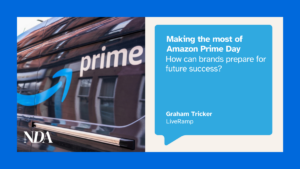By Josh Partridge, Head of EMEA at Yahoo
This year, brands are adopting new tactics in order to stay relevant and keep customers engaged in the run up to Christmas. For example, November saw Domino’s release its first ever TV Christmas ad to put the pizza chain front-of-mind this festive season, while John Lewis’ iconic Christmas ad hit our screens earlier than ever before. This year, the retailer also welcomed My John Lewis customers to step foot inside the magic of the heartwarming ad with a unique immersive experience, in collaboration with Yahoo – bringing the festive spirit to life for the nation.
While the platforms marketers and brands are using to tell their Christmas story is ever-evolving, in order to truly connect with UK consumers this year, brands must first understand the fundamental values and concerns of their customer base – and then adapt their marketing strategies accordingly. We recently conducted research of 2,000 UK consumers to help marketers understand just that, and here are some of our key findings and related tips:
Marketing campaigns should instil confidence by kicking off earlier than usual
Global supply chains which have run smoothly for decades have suddenly been thrown out by a number of connected systemic issues, including disruptions to transport and labour shortages. The list of retailers warning about shortages in the run up to Christmas has been growing in recent weeks. As a result, the festive shopping season has kicked off earlier than usual as major players unveiled their high profile Christmas marketing campaigns.
Our research found that nearly half of consumers are concerned about these potential shortages this Christmas (46%), rising to 50% of 16-34s. As a result, 62% of shoppers will start their Christmas gift shopping pre-December, so it’s critical that businesses are investing in and kickstarting marketing strategies before the panic sets in. This will be key to maintaining customer loyalty and engagement, and with shoppers being more cautious, brands will need to work harder to build this trust.
Part of this trust will also rely on brands being honest about how any supply chain issues will impact consumers, and ensuring they are engaging with customers on these matters. Those brands which show up on social media, for example, to help answer customer queries around supply chains will be seen more favourably than brands that are seen to abandon consumers.
Brands must emphasise how they are making strides to improve sustainability while avoiding ‘greenwashing’
Our research found that 79% of consumers surveyed were more conscious of the increased packaging waste involved in online shopping. With ecommerce seeing a significant rise over the course of the last 18 months, online businesses should ensure they’re providing sustainable ways of delivering goods and services if they want to be kept front of mind and appeal to the growing demand from consumers to protect our planet.
Despite the growing demand for online shopping, this doesn’t just start and end with ecommerce. It applies to traditional bricks and mortar too, with highstreet brands and retailers ensuring they’re continuing to stress the value they place on sustainability and work together to take robust action. In fashion and textiles, over 50% of C-Suite executives say consumer demand is driving their pursuit of sustainability, revealing that brands are responding, but perhaps not fast enough.
Brands can, and should, shout about their sustainability efforts, as long as these are not empty promises. Consumers will continue to educate themselves, so it’s important that sustainability acts as a north star in a brand’s activity this Christmas and beyond.
Allow flexible payments through services such as Buy Now, Pay Later (BNPL)
The financial mood of the nation has changed. Surging inflation is squeezing household budgets and the likelihood of interest rate rises is continuing to impact the cost of borrowing. It’s therefore unsurprising that consumers are feeling the pressure financially.
Our research found that shoppers have increased financial concerns this year, with 16% of those surveyed saying that they will spend less. This trend is also significantly higher amongst females (19%) and the 24-44 age bracket (22%). Businesses should help consumers by allowing them their preferred method of payment. BNPL services can be particularly helpful to customers concerned about spending, and in fact, 39% of shoppers will use BNPL for Christmas shopping. There’s no denying that BNPL services have been gaining traction over recent years. So for brands, offering these payment alternatives will be key to capturing Christmas spend. And for marketers, highlighting this offering will be critical.
So whether it’s environmentally conscious shopping, savvy spending or concerns over supply, brands should expect to see consumers display altered behaviours this year, and they can take note and more importantly, take action, to ensure they’re able to maximise sales. It’s also important to remember, that despite these concerns, consumers will be looking for brands to help them feel festive.
So while responding to the above factors is key, marketers and brands should also ensure they’re striving to create engaging and meaningful experiences that bring the Christmas spirit to life for shoppers in their own unique way, whether that be virtually, or within physical stores – or, as we increasingly see from projects like our work with Selfridges and fashion designer Charli Cohen, the blending of both.









